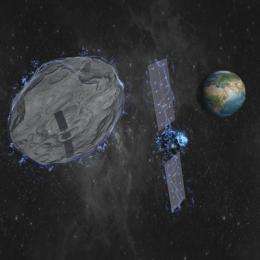World's researchers prepare for a cosmic encounter

(PhysOrg.com) -- The first International Academy of Astronautics Planetary Defence Conference is being held in Granada, Spain, on 27-30 April. Among the topics under discussion will be preparations for the near-Earth flyby of asteroid Apophis in 2029.
This year marks an important anniversary in the history of scientific research: Galileo's first astronomical use of the telescope, four centuries ago. It has also set the scene for new efforts in planning for future discoveries. On 13 April 2029 - twenty years from now - the Earth flyby of asteroid Apophis may become a significant milestone in our understanding of Earth's closest neighbours, the Near-Earth Objects (NEOs). World experts on the subject will discuss how best to prepare for the flyby at a conference that starts next week.
At the first International Academy of Astronautics (IAA) Planetary Defence Conference, specialists in astrometry, orbital dynamics, physical characterisation of asteroids and comets, aerothermodynamics, and impact modelling will join spacecraft mission designers, risk analysts, systems engineers and policy-makers to debate asteroid impacts as a topic for interdisciplinary research and as a threat to be addressed.
Making plans ahead of time
To make the most of the opportunity presented by the Apophis flyby, it is important that by the time it occurs our research capabilities are at their best, with even more students in universities developing studies concerning NEOs. For this reason, linked to the conference, ESA has organised a contest. The objective is to allow young researchers to propose and present their work and, together with well-recognised experts in the field, explore new aspects of asteroid science and engineering
Even if asteroid Apophis - a mountain of rock 270 m across, weighing about 20 million tonnes - is not a real danger, it is quite representative of a type of object that presents a serious impact threat. The threat is a combination of their size and huge kinetic energy, and their frequent close approaches to our planet - at intervals of some hundreds to thousands of years, on average. For this reason, the conference will use the visit of Apophis as a catalyst for applied research in asteroid studies.
"It is an attractive subject for many researchers, as in the studies about these objects - and on the space missions related to them - many leading-edge scientific and technical fields are combined," said Andrés Gálvez, ESA' General Studies Programme manager and a member of the conference organising committee. "Finding new solutions or shedding light on the unknowns relating to NEOs demands a great deal of creativity; studying how to avoid a possible catastrophe on a planetary scale is a particularly compelling challenge," remarked Gálvez.
The new ESA Space Situational Awareness (SSA) initiative will be also presented at the IAA Planetary Defence Conference. "The risk that a Near-Earth Object hits us is low - but when it does, it may do a lot of damage. A NEO impact is the only natural threat which we have the technical capability to mitigate - so we should prepare for it," says Detlef Koschny, working in ESA's SSA programme.
Provided by European Space Agency (news : web)

















